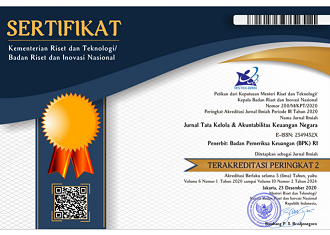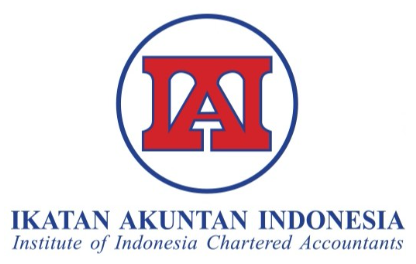Ergonomic Interventions in the Implementation of Risk-Based Audit to Overcome Dysfunctional Auditor Behavior
DOI:
https://doi.org/10.28986/jtaken.v8i1.627Keywords:
ergonomics, Risk based audit, time budget pressureAbstract
It is undeniable that auditors are expected to develop a strong audit plan to produce value-added audit reports. Given the preceding, current practice in auditing shows that many auditors use Risk-Based Audit (RBA) to determine an appropriate audit scope. RBA could effectively guide auditors to define audit scope based on the assessed risk. However, RBA does not consider human factors in performing audits. Consequently, most auditors encounter time budget pressure in meeting tight audit deadlines. Such an issue could adversely affect auditors' productivity and health. On the other hand, ergonomics is a discipline that focuses on human capabilities in completing tasks. The study also guides employees to adapt to the job while improving their well-being and increasing the quality of work results. Therefore, this study aims to intervene the principles of RBA with ergonomics. RBA consists of three stages: risk assessment, response, and reporting. The authors have concluded that ergonomics could intervene in RBA in the risk response step once the risk level is determined in the risk assessment phase by conducting a literature review study. Therefore, the auditors should balance the time budget allocation based on the assessed audit risk (low, moderate, or high). As the entity's risk is high, the audit team should be given an extended time allocation and vice versa. The findings suggest that auditors should develop an appropriate time budget scheme for specific audit procedures based on the assessed risks resulting from RBA implementation.
References
Agoglia, C. P., Hatfield, R. C., & Brazel, J. F. (2009). The effects of audit review format on review team judgments. Auditing, 28(1), 95-111. Retrieved from https://www.proquest.com/scholarly-journals/effects-audit-review-format-on-team-judgments/docview/216742002/se-2?accountid=86413
Aisha, A. N. (2014). Office ergonomics assessment pada kantor Bank X. Jurnal Rekayasa Sistem dan Industri, 1(1), 68-74. Retrieved from https://jrsi.sie.telkomuniversity.ac.id/JRSI/article/view/127
Anonymous. (2006). Audit evidence. Journal of Accountancy, 201(5), 113-116. Retrieved from https://www.proquest.com/trade-journals/audit-evidence/docview/206781286/se-2?accountid=86413
Bechara, M., & Kapoor, G. (2012). Maximizing the value of a risk-based audit plan: Certified public accountant. The CPA Journal, 82(3), 28-30. Retrieved from https://www.proquest.com/scholarly-journals/maximizing-value-risk-based-audit-plan/docview/1010401131/se-2?accountid=86413
BPK RI. (2015). Konsep laporan hasil reviu pemerolehan keyakinan mutu pemeriksaan tahun 2015 pada perwakilan Provinsi Banten di Serang (No. 28/LHR/XI-XI.1/12/2015). Jakarta: BPK RI.
BPK RI. (2016). Laporan hasil reviu pemerolehan keyakinan mutu pemeriksaan tahun 2016 pada BPK Perwakilan Provinsi Lampung di Bandar Lampung (No. 15/LHR/XI-XI.1/11/2017). Jakarta: BPK RI.
BPK RI. (2017). Laporan hasil reviu pemerolehan keyakinan mutu pemeriksaan tahun 2017 pada BPK Perwakilan Provinsi Sulawesi Selatan di Makassar (No. 12/LHR/XI=XI.1/11/2016). Jakarta: BPK RI.
Castanheira, N., Lúcia, L. R., & Russell, C. (2010). Factors associated with the adoption of risk-based internal auditing. Managerial Auditing Journal, 25(1), 79-98. DOI: 10.1108/02686901011007315
Dejnaronk, J., Little, H. T., Mujtaba, B. G., & McClelland, R. (2015). Factors influencing the effectiveness of the internal audit function in Thailand. Paper presented at the Research for Development, Bangkok, Thailand. Retrieved from https://scholar.google.com/scholar?hl=id&as_sdt=0%2C5&q=internal+audit+function+in+Thailand&btnG=
Desta, O., Kustono, D., & Patmanthara, S. (2016). Kontribusi ergonomi komputer, kelengkapan fasilitas, dan kesesuaian fasilitas praktik terhadap kesehatan ergonomi komputer (studi paket keahlian multimedia UPT Pelatihan Kerja Singosari). Jurnal Pendidikan, 1(8), 1626-1632. DOI: 10.17977/jp.v1i8.6689
Florea, R., & Florea, R. (2011). Audit techniques and audit evidence. Economy Transdisciplinarity Cognition, 14(1), 350-358. Retrieved from https://www.proquest.com/scholarly-journals/audit-techniques-evidence/docview/1118588979/se-2?accountid=86413
Frederick, L., Habes, D., & Schloemer, J. (1984). An introduction to the principles of occupational ergonomics. Occupational Health Nursing, 32(12), 643-645. DOI: 10.1177/216507998403201206
Gundry, L. C., & Liyanarachchi, G. A. (2007). Time budget pressure, auditors' personality type, and the incidence of reduced audit quality practices. Pacific Accounting Review, 19(2), 125-152. DOI: 10.1108/01140580710819898
Juliyanty, S. T., Eko, G. S., Rahman, A. F., & Subekti, I. (2019). An analysis of the factors which influence dysfunctional auditor behavior. Problems and Perspectives in Management, 17(1), 257-267. DOI: 10.21511/ppm.17(1).2019.22
Latar, M. A. (n.d.) Pengukuran kelelahan [PowerPoint slides]. Retrieved from https://digilib.esaunggul.ac.id/public/UEU-paper-6683-08_Kelelahan_-Subyektif-1.pdf
Malik, A. (2017, February 11). Ernst & Young Indonesia didenda di AS, ini tanggapan Indosat. Tempo. Retrieved from https://bisnis.tempo.co/read/845617/ernst-young-indonesia-didenda-di-as-ini-tanggapan-indosat
Mardhia, M. M., & Bariyah, C. (2020). Analisis beban kerja mental terhadap aplikasi dengan antarmuka cerdas. Jurnal Teknologi Informasi dan Ilmu Komputer, 7(2), 131-138.
Maulidawati, Islahuddin, & Abdullah, S. (2017). Pengaruh beban kerja dan tekanan anggaran waktu terhadap kualitas audit dengan pengalaman audit sebagai pemoderasi. Jurnal Administrasi Akuntansi: Program Pascasarjana Unsyiah, 6(2), 65-74.
Monoarfa, R., & Dama, H. (2018). The influence of time budget pressure and dysfunctional behavior on audit quality at Bawasda in Gorontalo Province. Jurnal Akuntansi, 22(3), 420-436. DOI: 10.24912/ja.v22i3.397
Mustika, P. W., & Sutajaya, I. M. (2016). Ergonomi dalam pembelajaran menunjang profesionalisme guru di era global. Jurnal Pendidikan Indonesia, 5(1), 82-96. DOI: 10.23887/jpi-undiksha.v5i1.8933
Nadirsyah, Indriani, M., & Usman, I. (2011). Pengaruh anggaran waktu audit, kompleksitas dokumen audit dan pengalaman auditor terhadap pertimbangan audit sampling pada Badan Pemeriksaan Keuangan (BPK) Republik Indonesia perwakilan Provinsi Aceh. Jurnal Telaah & Riset Akuntansi, 4(2), 176-186.
Nirmala, R. P. A., & Cahyonowati, N. (2013). Pengaruh independensi, pengalaman, due professional care, akuntabilitas, kompleksitas audit, dan time budget pressure terhadap kualitas audit (Studi empiris pada auditor di KAP di Jawa Tengah dan DIY). Diponegoro Journal of Accounting, 2(3), 1-13.
Nyarombe, F., Musau, E. G., Kavai, I., & Kipyegon, K. (2015). The effect of risk-based audit approach on the implementation of internal control system: a case of Uasin Gishu County. International Journal of Business and Management Invention, 4(1), 12-32.
Pradini, A. H., Lucitasari, D. R., & Putro, G. M. (2019). Perbaikan sistem kerja dengan pendekatan macroergonomic analysis and design (MEAD) untuk meningkatkan produktivitas pekerja. Jurnal Optimasi Sistem Industri, 12(1), 36-47. DOI: 10.31315/opsi.v12i1.2897
Prem, L. J. (2020). Determinants affecting internal audit effectiveness. Emerging Markets Journal, 10(2), 10-17. DOI: 10.5195/emaj.2020.208
Purnama, L. I., Dewi, L. T., & Yuniartha, D. R. (2015). Implementasi desain fasilitas kerja ergonomis untuk menurunkan resiko pada postur kerja duduk statis. Jurnal Rekayasa Sistem Industri, 4, 33-37.
Saito, K. (1999). Measurement of fatigue in industries. Industrial Health, 37, 134-142. Retrieved from https://www.jstage.jst.go.jp/article/indhealth1963/37/2/37_2_134/_article/-char/ja/
Sastra, C. D., Yuhertiana, I., & Budiwitjaksono, G. S. (2018). The use of risk-based audit techniques in government entities: Indonesia case. Account and Financial Management Journal, 6(3), 1581-1586. DOI: 10.31142/afmj/v3i6.04
Setiawan, H. (2015). Desain organisasi kerja berbasis ergonomi di stasiun kerja blanket basah industry karet Palembang. Jurnal Ilmiah Pengetahuan dan Penerapan Teknik Industri, 13(2), 193-204. DOI: 10.12928/si.v13i2.2696
Setyawan, F. E. B. (2011). Penerapan ergonomi dalam konsep kesehatan. Jurnal Ilmu Kesehatan dan Kedokteran Keluarga, 7(1), 39-49. DOI: 10.22219/sm.v7i1.1085
Shbail, M. O. A., Salleh, Z., & Nor, M. N. M. (2018). The effect of ethical tension and time pressure on job burnout and premature sign-off. Journal of Business and Retail Management Research, 12(4). Retrieved from https://www.proquest.com/scholarly-journals/effect-ethical-tension-time-pressure-on-job/docview/2080783111/se-2?accountid=86413
Silaban, A. (2012). Perilaku disfungsional auditor dalam pelaksanaan program audit. Jurnal Akuntansi, 16(2). 308-320. DOI: 10.24912/ja.v16i2.536
Smith, K. J., Emerson, D. J., & Boster, C. R. (2018). An examination of reduced audit quality practices within the beyond the role stress model. Managerial Auditing Journal, 33(8), 736-759. DOI: 10.1108/MAJ-07-2017-1611
Susihono, W., & Adiatmika, I. P. G. (2017). Implementation of total ergonomics approaches through multidisciplinary sciences for the improvement of workers' health quality: Literature review doctoral dissertation Udayana Bali-Indonesia. Journal of Global Pharma Technology, 9(9), 252-256. Retrieved from https://simdos.unud.ac.id/uploads/file_penelitian_1_dir/9c83f42bd3d7ee254faa91ead24babc0.pdf
Tuanakotta, T. M. (2013). Audit berbasis ISA (International Standards on Auditing). Jakarta: Salemba Empat.
Wiratama, R., Ng, S., & Lukman, L. (2019). Job burnout dan Reduced Audit Quality Practices (RAQP) dalam perspektif role stress. Jurnal Sistem Informasi, Manajemen dan Akuntansi, 17(1), 42-83. DOI: 10.35129/simak.v17i01.71
Zacchea, N. M. (2003). Risk-based audit target selection can increase the probability of conducting value-added audits. The Journal of Government Financial Management, 52(1), 22-28.
Downloads
Submitted
Accepted
Published
How to Cite
Issue
Section
License

Jurnal Tata Kelola dan Akuntabilitas Keuangan Negara is licensed under
a Creative Commons Attribution-ShareAlike 4.0 International License




















